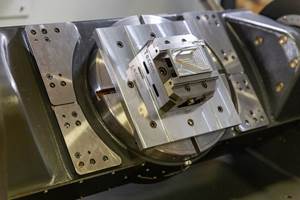Digitizing Tool Data Is Key to Integration with CNC Programming and Other Applications
ISO 13399 is an international standard for the digital representation of cutting tool data. Generic Tool Catalog (GTC) is a complement to ISO 13399 for vendor-neutral classification of cutting tools and data file structures.
Share





ISO 13399 is an international standard for the digital representation of cutting tool data. Generic Tool Catalog (GTC) is a complement to ISO 13399 for vendor-neutral classification of cutting tools and data file structures. These developments link cutting tool information with applications supporting data-driven manufacturing. However, complying with these standards is no trivial task for cutting tool manufacturers. Changing internal product codes and database structures can have a significant impact on personnel and IT resources. Smaller tool companies may face the greatest challenge.
However, the experience of one specialty cutting tool supplier, Destiny Tool (Santa Clara, California) shows that the conversion can be manageable, and it benefits both the company and its customer base. Destiny Tool’s specialty is a series of high-performance end mills for use on non-ferrous and high-temperature alloys.
To make the leap to a fully digitized tool catalog, Destiny Tool solicited the help of MachiningCloud, a developer of cloud-based applications, resources and services focused primarily on cutting tools and related manufacturing data. MachiningCloud provided this manufacturer with the service of mapping its product data into ISO 13399 and GTC formats and publishing them in the cloud. This means that the data can be accessed via the internet from a local computer without downloading entire catalogs, which are very large files. Destiny Tool’s customers can find this product data as a MachiningCloud online resource, eliminating the need to search through printed catalogs, make telephone calls or check multiple websites to find appropriate tooling. By using ISO 13399 and GTC, the product data residing on MachiningCloud is also easily imported into shop software that supports these standards.
Digital tool catalogs represent a major shift in the manufacturing industry. At a glance, the benefits to end users are compelling. Digital tool catalogs help them:
-
Find cutting tools faster.
-
Make smarter CNC cutting tool selections.
-
Quickly create cutting tool assemblies.
-
Simplify the CNC cutting tool workflow.
Time savings reported by users range from 25 to 75 percent when compared to traditional methods of tool selection. Beyond cutting tool selection, CAD/CAM programmers also can increase efficiency by using more productive metal removal rates and improved utilization of manufacturing assets.
Some cutting tool suppliers have concerns, however. Perceived risks to GTC integration include:
-
Brand degradation. A brand’s tools will be compared to other brands where the results appear homogenous.
-
Fewer customers. Customers will see other cutting tool options and may buy those instead, but brands not present in third-party tool marketplaces also risk losing customers when their products can’t be chosen in their preferred software.
-
Less control. Uploading a brand’s digital catalog to a third party results in a loss of control over end users’ experiences.
-
Requires resources. Services to help digitize a brand’s catalog are available, but it still requires significant internal resources.
These concerns must be balanced against many perceived benefits. These include:
-
Better customer data. Users can transmit results to suppliers, thus resulting in better recommendations and product refinements.
-
Increased efficiency. Once a digital catalog is created, maintaining up-to-date information is much easier.
-
More customers. Third-party integration increases reach and exposure, and presents a cutting tool brand among its competition.
-
Ease of use. GTC allows cutting tool brands to digitize without creating a proprietary system.
Perhaps the most important deciding consideration is this: There is an advantage to converting to a digital tool catalog sooner rather than later. Over time, as CAD/CAM programmers use brand-neutral tooling selection software, brands that aren’t present in the GTC format will experience a loss of market share as competitors gain new users. Finally, there is no stopping the movement toward data-driven manufacturing. The availability of cutting tool data in an importable, digital format is giving this movement added momentum.
Related Content
Four Questions (& Answers) About Data-Driven Process Improvement at CNC Job Shops
How can shops can make informed decisions using data-driven feedback to improve shopfloor efficiency and profitability? And how will these technologies differ between high- and low-volume production?
Read MoreCan Connecting ERP to Machine Tool Monitoring Address the Workforce Challenge?
It can if RFID tags are added. Here is how this startup sees a local Internet of Things aiding CNC machine shops.
Read MoreDiving Deeper Into Machine Monitoring Data
Data visualization is the first step in using machine monitoring data, but taking it to the next level requires looking for trends within the data.
Read MoreHow this Job Shop Grew Capacity Without Expanding Footprint
This shop relies on digital solutions to grow their manufacturing business. With this approach, W.A. Pfeiffer has achieved seamless end-to-end connectivity, shorter lead times and increased throughput.
Read MoreRead Next
Setting Up the Building Blocks for a Digital Factory
Woodward Inc. spent over a year developing an API to connect machines to its digital factory. Caron Engineering’s MiConnect has cut most of this process while also granting the shop greater access to machine information.
Read MoreRegistration Now Open for the Precision Machining Technology Show (PMTS) 2025
The precision machining industry’s premier event returns to Cleveland, OH, April 1-3.
Read MoreBuilding Out a Foundation for Student Machinists
Autodesk and Haas have teamed up to produce an introductory course for students that covers the basics of CAD, CAM and CNC while providing them with a portfolio part.
Read More
















.jpg;maxWidth=300;quality=90)













